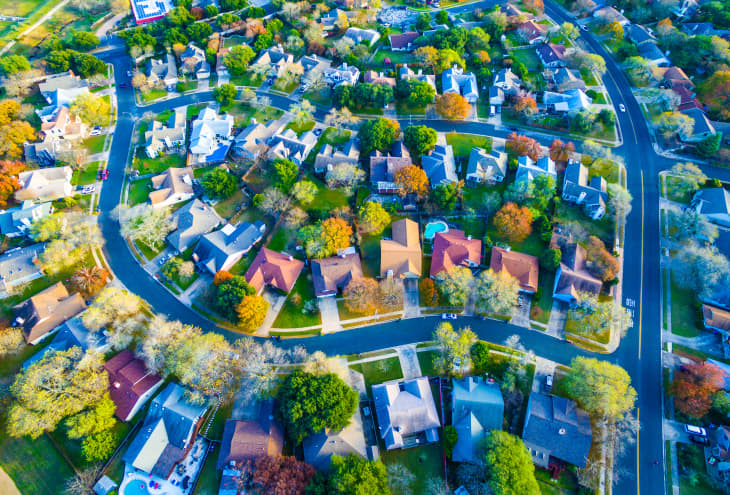The Suburb of The Future Could Be Free of Driveways and More Drone Friendly

Love ’em or hate ’em, it appears American suburbs are here to stay. But they might look very different 50 or even ten years from now.
That’s according to Alan M. Berger, professor of landscape architecture and urban design at the Massachusetts Institute of Technology, who explained his vision for more sustainable suburban development in the New York Times this past weekend.
New technology will allow us to reduce or eliminate some environmentally distasteful trappings of Suburbia.
For a while there, it looked like millennials were eschewing the suburbs in favor of the walkable whimsy of the city, where food, friends, and nightlife are all close at hand. It turns out, however, they’re actually moving to the ‘burbs after all, just like any other generation. (Though I’d argue a preference for urban living could have helped drive up prices in downtown areas over the past few years — the average urban home is worth more than its suburban counterpart for the first time in modern memory — which in turn forced more millennials to look outside the pricey urban core once they were ready to buy a home. Because every preference has a price limit.)
“Housing affordability is a major driver of the appeal of suburbia, which has historically been, and still is, more affordable, especially for first-time home buyers,” Berger writes. “Yet millennial suburbanites want a new kind of landscape. They want breathing room but disdain the energy wastefulness, visual monotony and social conformity of postwar manufactured neighborhoods.”
Drones will be able to deliver packages right to our doorsteps, reducing the need for minor errands and their accompanying traffic and emissions.
Can’t argue with that. With 70% of Americans still living in suburbs, Berger says, the powerful millennial cohort could potentially usher in a sustainable and communal model that’s more living room than bedroom community. And just as the Internet of Things is turning our appliances into efficient household assistants, perhaps we’re approaching the age of the “smart suburb.”
New technology will allow us to reduce or eliminate some environmentally distasteful trappings of Suburbia, Berger says, such as cars, driveways, and garages. Drones will be able to deliver packages right to our doorsteps, for example, reducing the need for minor errands and their accompanying traffic and emissions. And self-driving electric cars can be parked off-site at solar charging stations and summoned to the nearest curbside pull-off when needed.
Instead of a maze of paved cul-de-sacs, a future suburb might have two teardrop-shaped, one-way loops for cars, and more pedestrian paths that criss-cross common green spaces.
Anyone who’s lived on or near a college campus can probably appreciate this model.
“Before we had fenced-off backyards. In the future we’ll have common recreation spaces or vegetable gardens.”
Indeed, the element of Berger’s fantasy suburb I’m most enamored with is the landscape. Instead of parceled-off lawns, he envisions shared spaces better able to handle the changing climate. “The neighborhoods will be friendlier for pedestrians, with sidewalks and paths that connect to open spaces and communal areas,” he writes. “Before we had fenced-off backyards. In the future we’ll have common recreation spaces or vegetable gardens. Or they can be designed for shared landscape features like forest, vernal ponds or wetlands that help manage storm runoff and control flooding.”
Our American obsession with pristine lawns is an environmental calamity — sucking up precious freshwater in arid areas, and sloughing chemical fertilizers into the water supply. Meanwhile, I’ve never understood our feverish expectations of privacy outdoors.
In many northern European countries, there’s an unspoken (though increasingly legislated) “right to roam,” meaning people can freely walk through portions of private property for recreational purposes. If you’ve ever meandered among a field of sheep in Ireland or Scotland, you might have been traipsing through someone’s backyard — and on a hiking trail at the same time. Try that in some parts of America, meanwhile, and you may very well be shot.
And that right there is what makes me wonder whether America is really ready for the suburb of the future. A majority of 10,000 homeowners polled by Gartner said they preferred “dumb home” technology — stuff with dials and knobs — to apps that can control the temperature or lighting in their home. I’m willing to bet those folks like their driveways, too.
As for myself, I think I prefer the suburbs of the past, to be honest. Not the Eisenhower highway towns of the mid- to late 20th century, mind you, but those of the more distant past: the streetcar suburbs that grew around major cities in the late 1800s and early 1900s and later became small cities in their own right. Think Evanston, Ill., north of Chicago, or Newton, Mass., next to Boston. These areas, sometimes called “urban light” by city planner types, were apparently all the rage with millennials… err, about five years ago.
What do you think the suburb of the future will look like?